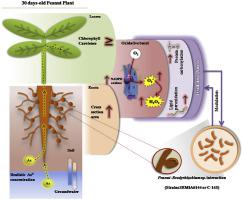Chemosphere ( IF 8.1 ) Pub Date : 2020-06-21 , DOI: 10.1016/j.chemosphere.2020.127410 Juan Manuel Peralta 1 , Claudia N Travaglia 2 , María C Romero-Puertas 3 , Ana Furlan 2 , Stella Castro 2 , Eliana Bianucci 2

|
Arsenic (As) can be present naturally in groundwater from peanut fields, constituting a serious problem, as roots can accumulate and mobilize the metalloid to their edible parts. Understanding the redox changes in the legume exposed to As may help to detect potential risks to human health and recognize tolerance mechanisms. Thirty-days old peanut plants inoculated with Bradyrhizobium sp. strains (SEMIA6144 or C-145) were exposed to a realistic arsenate concentration, in order to unravel the redox response and characterize the oxidative stress indexes. Thus, root anatomy, reactive oxygen species detection by fluorescence microscopy and, ROS histochemical staining along with the NADPH oxidase activity were analyzed. Besides, photosynthetic pigments and damage to lipids and proteins were determined as oxidative stress indicators. Results showed that at 3 μM AsV, the cross-section areas of peanut roots were augmented; NADPH oxidase activity was significantly increased and O2˙¯and H2O2 accumulated in leaves and roots. Likewise, an increase in the lipid peroxidation and protein carbonyls was also observed throughout the plant regardless the inoculated strain, while chlorophylls and carotenes were increased only in those inoculated with Bradyrhizobium sp. C-145. Interestingly, the oxidative burst, mainly induced by the NADPH oxidase activity, and the consequent oxidative stress was strain-dependent and organ-differential. Additionally, As modifies the root anatomy, acting as a possibly first defense mechanism against the metalloid entry. All these findings allowed us to conclude that the redox response of peanut is conditioned by the rhizobial strain, which contributes to the importance of effectively formulating bioinoculants for this crop.
中文翻译:

揭示砷对接种两种不同的缓生根瘤菌菌种的花生植物氧化还原反应的影响。株。
砷可能自然存在于花生田的地下水中,这构成了一个严重的问题,因为根可以积累并将准金属迁移至其可食用部分。了解暴露于砷的豆类中的氧化还原变化可能有助于发现对人体健康的潜在风险并认识耐受机制。接种了根瘤菌的30天大的花生植株sp。菌株(SEMIA6144或C-145)暴露于实际的砷酸盐浓度,以阐明氧化还原反应并表征氧化应激指数。因此,分析了根部解剖,通过荧光显微镜检测活性氧种类,ROS组织化学染色以及NADPH氧化酶活性。此外,光合色素和对脂质和蛋白质的破坏被确定为氧化应激指标。结果表明,在3μMAs V下,花生根的横截面积增加;NADPH氧化酶活性显着增加,O 2 and和H 2 O 2积累在叶和根中。同样,无论接种菌株如何,在整个植物中也观察到脂质过氧化和蛋白质羰基的增加,而仅在接种了根瘤菌属的那些中叶绿素和胡萝卜素增加。C-145。有趣的是,主要由NADPH氧化酶活性引起的氧化爆发,其氧化应激是应变依赖性和器官分化的。此外,As修饰了根部解剖结构,可能是抵御准金属进入的第一个防御机制。所有这些发现使我们可以得出结论,花生的氧化还原反应受到根瘤菌菌株的调节,这有助于为该作物有效配制生物抑制剂。











































 京公网安备 11010802027423号
京公网安备 11010802027423号